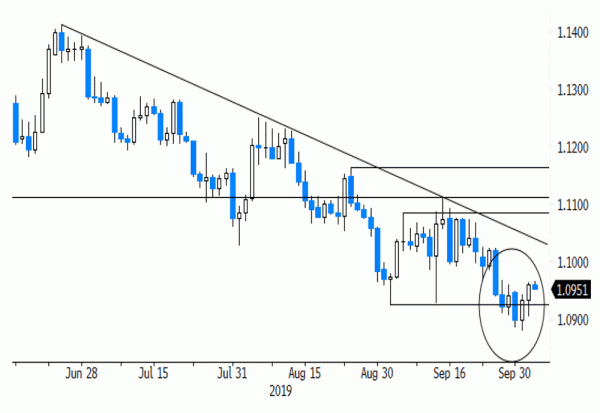Rates: August recession trade is back
German Bunds remarkably failed to gain ground in yesterday’s risk-off session which resembled August recession fear trading. US Treasuries hugely outperformed, bull steepening the curve, betting on the prospect of more Fed assistance. Downside risks to today’s US non-manufacturing ISM suggest more of the same.
Currencies: Will US ISM further undermine the dollar?
Uncertainty on the US economy and a global risk-off sentiment weighed on the dollar yesterday as the US currency lost substantial interest rate support. Even so, the technical picture of EUR/USD hasn’t changed in a profound way yet. A poor US non-manufacturing ISM might intensify the USD correction. USD/JPY looks most vulnerable
The Sunrise Headlines
- Wall Street extended its post-ISM decline yesterday. The Dow Jones underperformed, tumbling 1.86%. Asian equities also trade in negative territory. Japan underperforms (-2%).
- The US will impose 25% tariffs on $7.5bn of a variety of European goods. The move comes after the WTO ruled in favour of the US in the case over illegal aircraft subsidies to Airbus.
- Democratic presidential candidate Bernie Sanders postpones all campaign events ‘until further notice’. Sanders got hospitalized yesterday for an artery blockage and underwent surgery.
- The EU is set to rule over how Polish courts should deal with ‘abusive clauses’ in the foreign-currency loans that Polish banks issued years ago. The ruling may trigger costs up to 60 bn zloty for the sector.
- PM Johnson will present his new Brexit plan to Parliament today. Johnson is optimistic the plan will get enough support. The EU meanwhile welcomed some concessions in the proposal but said some aspects in it are still unacceptable.
- Greek demonstrators marched through the streets of Athens yesterday to protest against the government’s labor market reforms. PM Mitsotakis plans a.o. to change some ground rules on how strikes can be declared.
- In today’s economic calendar we’ll focus on the US non-manufacturing ISM (September). Retail sales, PPI and final PMI’s are due in the euro zone. A slew of central bankers (Fed, ECB, BoE) are scheduled to speak
Currencies: Will US ISM Further Undermine The Dollar?
Will ISM trigger further USD selling?
EUR/USD initially returned part of Tuesday’s post-ISM gain yesterday. It was merely euro weakness. At the same time, USD/JPY held a downward bias, too. US ADP private job growth (137k) was close to expectations, but the August figure was downwardly revised. The impact on trading was limited, but US yields still declined more than EMU ones, putting the dollar in the defensive. The WTO allowed the US to impose tariffs on EU goods in a dispute on Aircraft subsidies, accelerating the risk-off move. On FX markets, the dollar declined further. EUR/USD finished at 1.0959 (from 1.0933). USD/JPY closed 107.15 (from 107.75).
Overnight, Asian equities show losses of up to 2.0%, joining yesterday’s sell-off in Europe and on WS. (US) yields hover near yesterday’s lows, but with no meaningful further decline (yet). The dollar also stabilizes after yesterday’s correction. EUR/USD trades near 1.0955. USD/JPY is holding in the low 117 area. This morning, European (equity) markets will look for a new equilibrium in the wake rising trade tensions between the US and Europe. However, the focus will soon turn to the US non-manufacturing ISM. Markets expect a modest decline from 56.4 to a still lofty 55.0. Given recent soft (US) data, markets will look for indications that manufacturing recession is further affecting domestic growth. A poor ISM will raise expectations that the Fed will ‘be obliged’ to cut rates further. Price action earlier this week suggests that the dollar is losing some shine. Especially USD/JPY looks vulnerable. The case for further euro gains is less outspoken. Even so, we assume EUR/USD will at least partially track a broader USD correction. From a technical point of view, the EUR/USD downtrend was well in place but shows tentative signs of easing. High-profile negative US news is probably still needed to reverse the USD uptrend. An incoming trendline at 1.1040 remains our first reference. EUR/USD 1.0864 (76% retr.) and 1.0778 (gap April 2017) are next supports.
UK PM Johnson at the Conservative party Congress highlighted a new Brexit proposal yesterday, with amendments to the Irish backstop clause. The reaction of sterling was limited as it was unclear whether the proposal could be the basis for further talks with the EU. Aside from the next episode in the Brexit sage, we also keep an eye at the UK services PMI. Indications on further EU-UK negotiations might ease recent GBP correction but we remain caution
EUR/USD: rebounds modestly on overall USD correction














